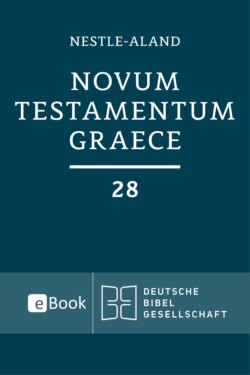Читать книгу Novum Testamentum Graece (Nestle-Aland) - Группа авторов, Nestle-Aland - Страница 66
2. The Apparatus in the Inner Margin
Оглавление1 2 3 4 etc.
Italic numbers of normal size in the inner margin represent the chapter divisions (kephalaia) most widely used in the manuscripts. It should be noted that the first section of each writing is not numbered (with the exception of Acts, Revelation, and some of the letters). Thus the kephalaia begin at 1,23 for Mark, at 2,1 for Matthew, etc. Where there is evidence for an alternative chapter division in the manuscripts, the respective number is given in parentheses. For example, chapter 31 of Acts begins at 21,18 according to the main tradition, at 21,15 according to an alternative strand.
| 1 |
| III |
or
| 2 |
| X |
etc.
For the Gospels the Eusebian section and canon numbers are also shown in the inner margins. (For Eusebius' letter to Carpian explaining the system and for the canon tables, see pp. 89*ff.17) They always stand at the beginning of a section, with the section number shown in Arabic numerals above the line. The Roman numeral below the line identifies the canon table showing the parallel pericope numbers. Thus Eusebius divided the four Gospels into small units by content, and organized them into ten canons. Canon I lists the pericopes represented in all four Gospels, canons II–IV those in three, canons V–IX lists those found in only two Gospels, and canon X lists the sections which are peculiar to each Gospel.
| 1 |
| III |
| 1 |
| III |
in the inner margin at Mt 1,1 means that parallel pericopes for section 1 of the Gospel of Matthew are listed in canon III. From canon table III (p. 92*) we find that section 1 of Matthew corresponds to section 14 of Luke (L 3,23-38) and sections 1, 3 and 5 of John (Jn 1,1-5.9-10.14).
| 2 |
| X |
| 2 |
| X |
at Mt 1,17 refers to canon table X, indicating that for this pericope there are no parallels, and that it represents material peculiar to Matthew.
✽
✽ is used to mark places where the beginning of an old chapter division does not unambiguously match the beginning of a verse (e.g., Lk 2,48).
Eusebius' synoptic system of sections and canon tables provides a glimpse of his remarkable work on the Gospels. It remains useful even today. It is used in many manuscripts as a very practical means of organizing the continuous text. In collating manuscripts it is an effective tool for locating passages. In this sense it can be useful in the present edition.
